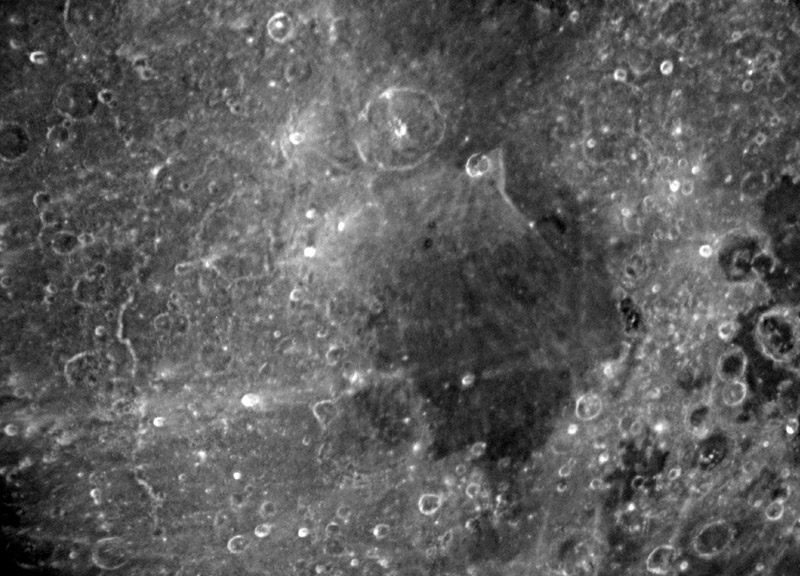|
|
| (5 intermediate revisions by the same user not shown) |
| Line 1: |
Line 1: |
| | __NOTOC__ | | __NOTOC__ |
| | =Chameleon Surface= | | =Chameleon Surface= |
| | + | <!-- Start of content --> |
| | <div class="post" id="post-121"> | | <div class="post" id="post-121"> |
| | | | |
| Line 6: |
Line 7: |
| | <p>[[File:Nectaras_and_Rays_Eskildsen.jpg|Nectaris full moon-Eskildsen]]<br /> | | <p>[[File:Nectaras_and_Rays_Eskildsen.jpg|Nectaris full moon-Eskildsen]]<br /> |
| | <em>image by [mailto:HowardEskildsen@msn.com Howard Eskildsen]</em></p> | | <em>image by [mailto:HowardEskildsen@msn.com Howard Eskildsen]</em></p> |
| − | <p>Here is a lunar surface caught in the act of changing its nature. Do you recognize Mare Nectaris and its surroundings at full Moon? When we see the mare under lower lighting the surface is dark and splotched only with a few small craters. But as the sun rises the darkness lightens and we can see rays from Tycho, Theophilus and other less easily traced sources. The effect of the rays is to veneer the mare darkness – due to dark minerals such as iron and magnesium – and gradually, ray by ray, convert it to a light-hued smooth terrain. If this process continues long enough it produces smooth light plains such as those near Hyginus and the Schiller-Zucchius basin. In some cases, small impact craters dig through the veneer and make dark halos – as seen here in Nectaris – confirming that old mare lavas lurk below. Here in Nectaris we have a delicate version of what we saw on the ejecta-penetrating radar [http://www.lpod.org/?m=200602 image] of the area near Crüger. </p> | + | <p>Here is a lunar surface caught in the act of changing its nature. Do you recognize Mare Nectaris and its surroundings at full Moon? When we see the mare under lower lighting the surface is dark and splotched only with a few small craters. But as the sun rises the darkness lightens and we can see rays from Tycho, Theophilus and other less easily traced sources. The effect of the rays is to veneer the mare darkness – due to dark minerals such as iron and magnesium – and gradually, ray by ray, convert it to a light-hued smooth terrain. If this process continues long enough it produces smooth light plains such as those near Hyginus and the Schiller-Zucchius basin. In some cases, small impact craters dig through the veneer and make dark halos – as seen here in Nectaris – confirming that old mare lavas lurk below. Here in Nectaris we have a delicate version of what we saw on the ejecta-penetrating radar [[February_28,_2006|image]] of the area near Crüger. </p> |
| | <p>[mailto:tychocrater@yahoo.com Chuck Wood]</p> | | <p>[mailto:tychocrater@yahoo.com Chuck Wood]</p> |
| | <p><strong>Technical Details:</strong><br /> | | <p><strong>Technical Details:</strong><br /> |
| Line 12: |
Line 13: |
| | <strong>Related Links:</strong><br /> | | <strong>Related Links:</strong><br /> |
| | Rükl charts 47 & 58<br /> | | Rükl charts 47 & 58<br /> |
| − | [http://www.lpod.org/archive/LPOD-2004-11-05.htm A wider view]</p> | + | [[November_5,_2004| A wider view]]</p> |
| − | <p align="center"><b>SUPPORT LPOD - VISIT A SPONSOR (CLICK AN AD BELOW)!</b></p> | + | <p><b>Yesterday's LPOD:</b> [[March 2, 2006|Mare Layering]] </p> |
| | + | <p><b>Tomorrow's LPOD:</b> [[March 4, 2006|Twin Peaks]] </p> |
| | + | <!-- Remove click bait --> |
| | </div> | | </div> |
| − | ---- | + | <!-- End of content --> |
| − | ===COMMENTS?===
| + | {{wiki/ArticleFooter}} |
| − | Register, and click on the <b>Discussion</b> tab at the top of the page.
| |




